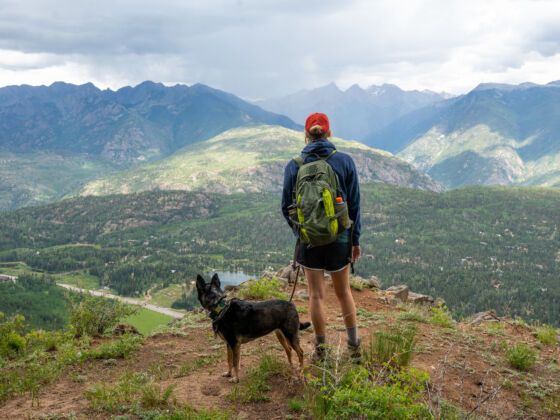7 ways to Do Colorado Right this summer
Summer in Colorado is nothing short of majestic. Whether you’re scaling one of the Rocky Mountains’ tallest peaks, exploring an artsy corner of a world-class city, or anything in between, you’re pretty much guaranteed a memorable adventure.
But how do you truly Do Colorado Right this summer? It starts not with a specific site or activity, but with a frame of mind. The disruption of 2020 has created an opportunity to rethink what it means to visit a place as a traveler, to serve as its steward. In Colorado, a simple way to do this is to embrace the Care For Colorado principles, developed by the state tourism office in partnership with the Leave No Trace Center for Outdoor Ethics. The Centennial State deserves nothing less.
First, read up; then, consider one of the seven incredible Colorado adventures outlined below. Don’t be surprised if you’ve never heard of them before — that’s what makes them extra special. And if we all follow the guidance of Care for Colorado, they’ll remain special for generations to come.

Larimer Street between 14th and 15th Streets — aka Larimer Square — is Denver’s oldest commercial block, dating back to the days of the Wild West. Every building here has a story to tell, from the ghosts that rattle the pipes of the Sussex Building to the letters and packages that made their way through Denver’s first post office.
Today, Larimer Square is a vibrant mix of art galleries, entertainment venues, hip bistros and bars, and headline-making restaurants. You can also expect beloved festivals and events like the Denver Chalk Art Festival and Denver Oktoberfest, plus live outdoor music during the warmer months. Larimer may no longer serve as the gateway to the western frontier, but there’s still plenty to take in and discover as you shop, dine, or just plain hang here under the canopy of lights.
Palisade is best known for its big, juicy peaches and its many family-owned wineries and vineyards. But this rich agricultural region on Colorado’s Western Slope — the fertile Grand Valley — is also an outdoor recreation hub, with some of the best terrain for hiking, cycling, and skiing in the state.
Case in point: The Palisade Plunge, an epic 32-mile trail that descends 6,000 feet from the 11,000-foot Grand Mesa to the Colorado River below. (What’s the Grand Mesa you ask? Only the largest flattop mountain in the world!) This purpose-built singletrack trail was designed with experienced mountain bikers in mind, but it’s also open to hikers, trail runners, and, on some sections, equestrians. Local shuttle companies can give you a ride to the top of the trail so you can make the one-way trip without worrying about retrieving your vehicle later.
Little is as magical as sleeping under the Colorado stars and waking up with the sun. Tucked away in Eleven Mile Canyon — a secluded, forested, and cliff-clinging stretch of the South Platte River, tumbling through a recreation area and state park — you’ll find numerous serene campsites that can serve as your home base for exploring this lesser-known spot an hour west of Colorado Springs.
Impressive rock-climbing areas, scenic waters for fly fishing, and numerous hiking trails mean you should pack whatever gear suits you. If you need a rest day, this is also a great spot to have a quiet picnic or coffee with that sunrise.
Every Colorado town enjoys superior access to the outdoors, but Durango has stats that are hard to beat: Two million acres of national forest surround this artsy, outdoorsy community in the state’s southwestern corner. What’s more, the Animas River flows right through town and offers tons of ways to play, whether you’re looking for a heart-pumping adventure or a more low-key outing.
There’s a four-mile section of the river with Gold Medal trout fishing, a hard-to-achieve designation that means you’re in for some seriously good casting. Tap a local guide who can take you to the river’s sweet spots, or book a fly-fishing lesson if you’re new to this relaxing sport. For more of a thrill, head to the Lower Animas to kayak, paddleboard, tube, or raft over churning Class III rapids. There are tons of experienced guides and outfitters who can help get you out on the river safely.
Some mountain bikers love the physical challenge of pedaling uphill in Colorado’s thin air. For others, it’s all about the thrill of riding downhill, letting gravity do most of the work as they cruise over rocky outcrops and around sharp curves.
You can dabble in a little of both when you visit Vail Valley, whether you’re a beginner or an experienced pro. Ride Beaver Creek Resort’s Centennial Express lift — with your bike in tow — and then take your pick of the many flowy singletrack trails that traverse through wildflower-speckled meadows, evergreen forest, and aspen groves across the mountain. When you stop to catch your breath, be sure to snap a few photos of the jaw-dropping views of the Rockies from this hard-to-beat vantage point.
Surfing? In the landlocked Centennial State? Yep — with a kayak, standup paddleboard, or a river surfboard, you can ride the “G-wave” at Glenwood Whitewater Park, a purpose-built standing wave on the Colorado River.
Depending on the season, the river’s flow ranges from 4,000 to 22,000 cubic feet per second, which means you can visit over and over again and have a different experience every time. This spot is so exceptional, it’s where the best freestyle kayakers in the country competed for a spot on the US championship team in 2009. And if you’re new to the world of river surfing, there’s also a smaller standing wave and several learning pools for practicing your skills (plus a terraced seating area if you’d rather just kick back and watch!).
Colorado’s many ski areas don’t just close up shop when the warm weather hits, mountains hibernating under wildflowers until the snow returns. In the summer, the slopes transform into a different kind of playground, complete with al fresco dining, hiking and mountain biking trails, aerial adventure coasters, ziplines, mountain coasters, and scenic gondola and chairlift rides.
But to get a little daring on Colorado’s summer mountains, tackle the Arapahoe Basin Ski Area via ferrata, a type of protected climbing route whose name means “iron way” or “iron path” in Italian (it was first developed by mountaineering soldiers in the Dolomites during World War I). You’ll safely and securely climb to 13,000 feet via iron handholds, routes varying in difficulty and length. No matter how or where you climb, expect sweeping panoramic views of the craggy Rockies and the unique high-alpine landscape below. A-Basin’s via ferrata is the highest in North America, so this is a true “only in Colorado” experience.

